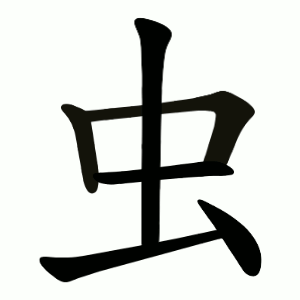Top Qs
Timeline
Chat
Perspective
Radical 142
Chinese character radical From Wikipedia, the free encyclopedia
Remove ads
Radical 142 or radical insect (虫部) meaning "insect" or "worm" is one of the 29 Kangxi radicals (214 radicals in total) composed of 6 strokes.
Remove ads
In the Kangxi Dictionary, there are 1067 characters (out of 49,030) to be found under this radical.
虫 is also the 131st indexing component in the Table of Indexing Chinese Character Components predominantly adopted by Simplified Chinese dictionaries published in mainland China.
The character 虫 models a worm. To derive from this, characters meaning creeping animals such as reptiles, insects, worms, amphibians, and shellfish are included in this radical. The character 虫 is used as the simplified form of 蟲 in Simplified Chinese and Japanese and occasionally in Traditional Chinese.
Remove ads
Evolution
- Oracle bone script character
- Bronze script character
- Small seal script character
Derived characters
Remove ads
Sinogram
The radical is also used as an independent Chinese character. It is one of the Kyōiku kanji or Kanji taught in elementary school in Japan.[1] It is a first grade kanji[1]
References
Literature
External links
Wikiwand - on
Seamless Wikipedia browsing. On steroids.
Remove ads




